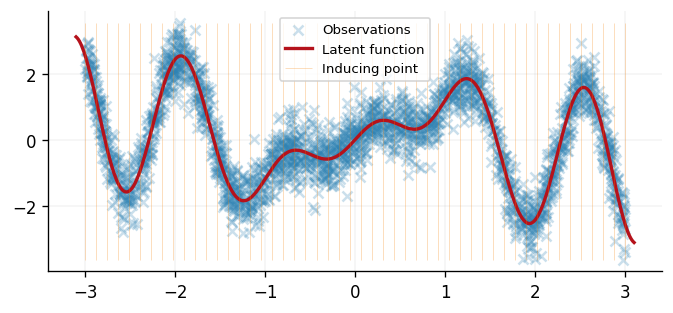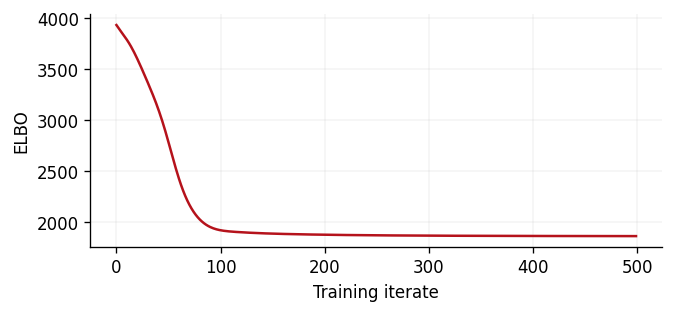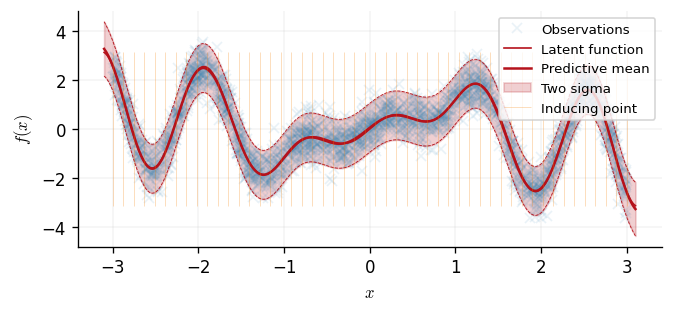Sparse Gaussian Process Regression
In this notebook we consider sparse Gaussian process regression (SGPR) Titsias (2009). This is a solution for medium to large-scale conjugate regression problems. In order to arrive at a computationally tractable method, the approximate posterior is parameterized via a set of pseudo-points . Critically, the approach leads to complexity for approximate maximum likelihood learning and per test point for prediction.
# Enable Float64 for more stable matrix inversions.
from jax import (
config,
jit,
)
import jax.numpy as jnp
import jax.random as jr
from jaxtyping import install_import_hook
import matplotlib as mpl
import matplotlib.pyplot as plt
import optax as ox
from examples.utils import use_mpl_style
config.update("jax_enable_x64", True)
with install_import_hook("gpjax", "beartype.beartype"):
import gpjax as gpx
from gpjax.parameters import Parameter
# set the default style for plotting
use_mpl_style()
key = jr.key(42)
cols = mpl.rcParams["axes.prop_cycle"].by_key()["color"]
Dataset
With the necessary modules imported, we simulate a dataset with inputs sampled uniformly on and corresponding independent noisy outputs
We store our data as a GPJax Dataset and create test inputs and
labels for later.
n = 2500
noise = 0.5
key, subkey = jr.split(key)
x = jr.uniform(key=key, minval=-3.0, maxval=3.0, shape=(n,)).reshape(-1, 1)
f = lambda x: jnp.sin(2 * x) + x * jnp.cos(5 * x)
signal = f(x)
y = signal + jr.normal(subkey, shape=signal.shape) * noise
D = gpx.Dataset(X=x, y=y)
xtest = jnp.linspace(-3.1, 3.1, 500).reshape(-1, 1)
ytest = f(xtest)
To better understand what we have simulated, we plot both the underlying latent function and the observed data that is subject to Gaussian noise. We also plot an initial set of inducing points over the space.
n_inducing = 50
z = jnp.linspace(-3.0, 3.0, n_inducing).reshape(-1, 1)
fig, ax = plt.subplots()
ax.scatter(x, y, alpha=0.25, label="Observations", color=cols[0])
ax.plot(xtest, ytest, label="Latent function", linewidth=2, color=cols[1])
ax.vlines(
x=z,
ymin=y.min(),
ymax=y.max(),
alpha=0.3,
linewidth=0.5,
label="Inducing point",
color=cols[2],
)
ax.legend(loc="best")
plt.show()

Next we define the true posterior model for the data - note that whilst we can define this, it is intractable to evaluate.
meanf = gpx.mean_functions.Constant()
kernel = gpx.kernels.RBF() # 1-dimensional inputs
likelihood = gpx.likelihoods.Gaussian(num_datapoints=D.n)
prior = gpx.gps.Prior(mean_function=meanf, kernel=kernel)
posterior = prior * likelihood
We now define the SGPR model through CollapsedVariationalGaussian. Through a
set of inducing points this object builds an approximation to the
true posterior distribution. Consequently, we pass the true posterior and initial
inducing points into the constructor as arguments.
We now train our model akin to a Gaussian process regression model via the fit
abstraction. Unlike the regression example given in the
conjugate regression notebook,
the inducing locations that induce our variational posterior distribution are now
part of the model's parameters. Using a gradient-based optimiser, we can then
optimise their location such that the evidence lower bound is maximised.
# Use the enhanced fit API with trainable parameter filtering
opt_posterior, history = gpx.fit(
model=q,
# we want want to minimize the *negative* ELBO
objective=lambda p, d: -gpx.objectives.collapsed_elbo(p, d),
train_data=D,
optim=ox.adamw(learning_rate=1e-2),
num_iters=500,
key=key,
trainable=Parameter,
)
0%| | 0/500 [00:00<?, ?it/s]
fig, ax = plt.subplots()
ax.plot(history, color=cols[1])
ax.set(xlabel="Training iterate", ylabel="ELBO")
[Text(0.5, 0, 'Training iterate'), Text(0, 0.5, 'ELBO')]

We show predictions of our model with the learned inducing points overlaid in grey.
latent_dist = opt_posterior(xtest, train_data=D)
predictive_dist = opt_posterior.posterior.likelihood(latent_dist)
inducing_points = opt_posterior.inducing_inputs.value
samples = latent_dist.sample(key=key, sample_shape=(20,))
predictive_mean = predictive_dist.mean
predictive_std = jnp.sqrt(predictive_dist.variance)
fig, ax = plt.subplots()
ax.plot(x, y, "x", label="Observations", color=cols[0], alpha=0.1)
ax.plot(
xtest,
ytest,
label="Latent function",
color=cols[1],
linestyle="-",
linewidth=1,
)
ax.plot(xtest, predictive_mean, label="Predictive mean", color=cols[1])
ax.fill_between(
xtest.squeeze(),
predictive_mean - 2 * predictive_std,
predictive_mean + 2 * predictive_std,
alpha=0.2,
color=cols[1],
label="Two sigma",
)
ax.plot(
xtest,
predictive_mean - 2 * predictive_std,
color=cols[1],
linestyle="--",
linewidth=0.5,
)
ax.plot(
xtest,
predictive_mean + 2 * predictive_std,
color=cols[1],
linestyle="--",
linewidth=0.5,
)
ax.vlines(
x=inducing_points,
ymin=ytest.min(),
ymax=ytest.max(),
alpha=0.3,
linewidth=0.5,
label="Inducing point",
color=cols[2],
)
ax.legend()
ax.set(xlabel=r"$x$", ylabel=r"$f(x)$")
plt.show()

Runtime comparison
Given the size of the data being considered here, inference in a GP with a full-rank covariance matrix is possible, albeit quite slow. We can therefore compare the speedup that we get from using the above sparse approximation with corresponding bound on the marginal log-likelihood against the marginal log-likelihood in the full model.
full_rank_model = gpx.gps.Prior(
mean_function=gpx.mean_functions.Zero(), kernel=gpx.kernels.RBF()
) * gpx.likelihoods.Gaussian(num_datapoints=D.n)
nmll = jit(lambda: -gpx.objectives.conjugate_mll(full_rank_model, D))
%timeit nmll().block_until_ready()
181 ms ± 4.14 ms per loop (mean ± std. dev. of 7 runs, 1 loop each)
1.47 ms ± 41.9 μs per loop (mean ± std. dev. of 7 runs, 1,000 loops each)
As we can see, the sparse approximation given here is much faster when compared against a full-rank model.
System configuration
Author: Daniel Dodd
Last updated: Mon Dec 15 2025
Python implementation: CPython
Python version : 3.11.14
IPython version : 9.5.0
matplotlib: 3.10.6
jaxtyping : 0.3.2
optax : 0.2.5
jax : 0.7.1
gpjax : 0.13.4
Watermark: 2.5.0